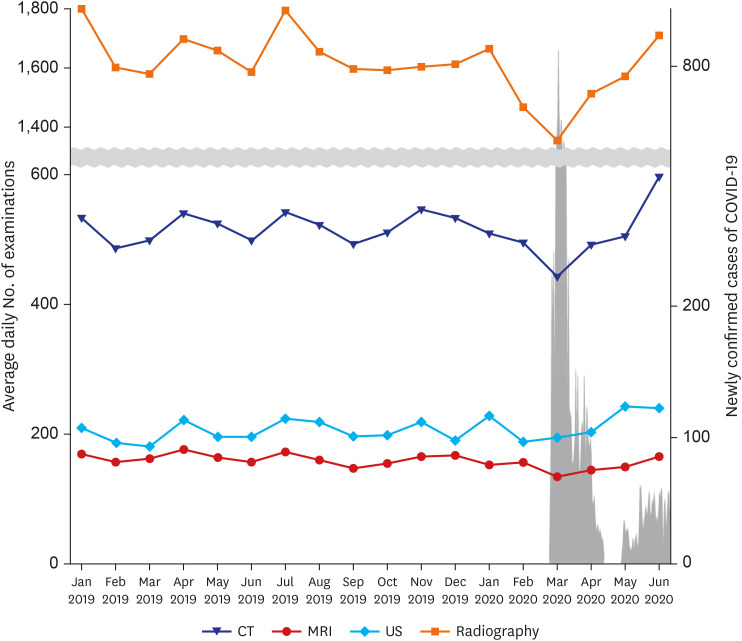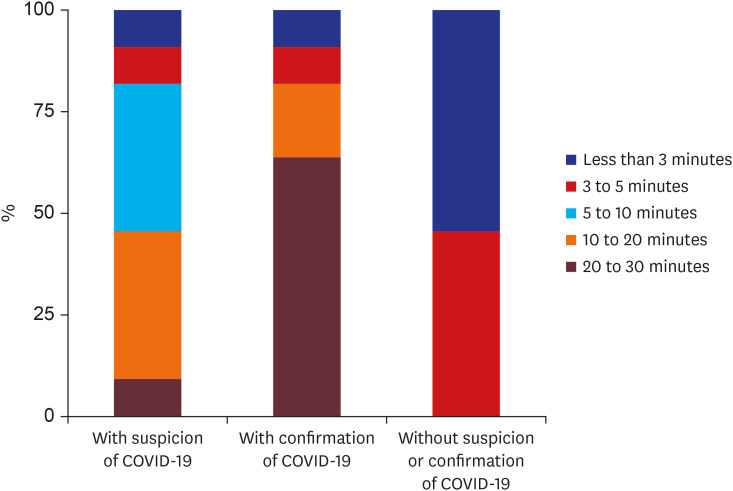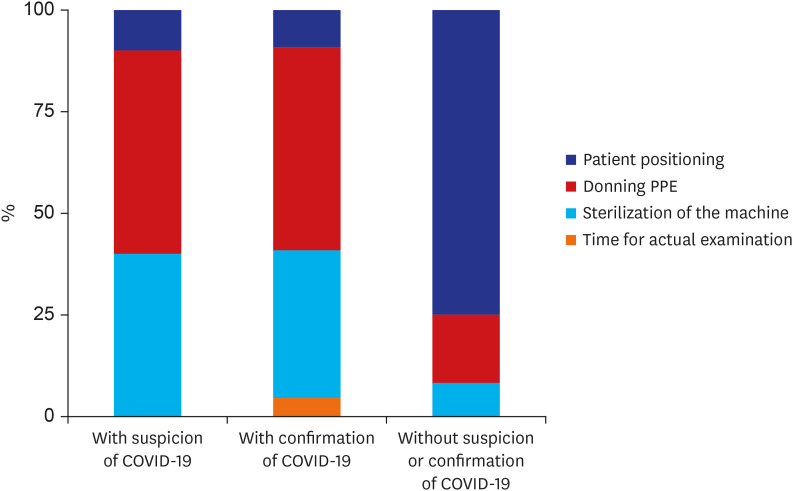J Korean Med Sci.
2020 Oct;35(40):e368. 10.3346/jkms.2020.35.e368.
The Impact of COVID-19 on the Use of Radiology Resources in a Tertiary Hospital
- Affiliations
-
- 1Department of Radiology, Seoul National University Bundang Hospital, Seongnam, Korea
- 2Department of Applied Bioengineering, Graduate School of Convergence Science and Technology, Seoul National University, Seoul, Korea
- KMID: 2507622
- DOI: http://doi.org/10.3346/jkms.2020.35.e368
Abstract
- Background
The coronavirus disease 2019 (COVID-19) has escalated to be a global threat to public health. Analysis of the use of radiology resources may render us insight regarding the public health behavior during pandemic. We measured the influence COVID-19 had on the use of radiology resources in terms of the number of examinations performed, and turnaround time for portable radiography.
Methods
This study was conducted at a tertiary hospital located in area where the prevalence of COVID-19 infection was low (0.01%). We compared the number of radiology examinations 1) before pandemic (in 2019) vs. during peak of pandemic (January to March 2020), and 2) before pandemic vs. after the peak of pandemic (April to June 2020) via t-tests. We repeated similar analyses for subgroups as follows: gender, age, department (outpatient, inpatient, emergency, screening), body parts, and modality. We also performed a survey of radiologic technologists regarding the turnaround time and rate-limiting step of portable radiography for patients with and without suspicion or confirmation of COVID-19.
Results
Although not statistically significant, the daily number of examinations during the peak of pandemic decreased by 9 percentage points (2,638 vs. 2,413; difference [95% CI], −225 [−489, 38]; P = 0.094). The percentage change was especially notable for children, emergency, and screening department (25, 19, and 44 percentage points, respectively). After the peak of the pandemic, the number of examinations increased back to near the prepandemic level (2,638 vs. 2,588; −50 [−317, 218]; P = 0.71). The turnaround time for portable radiography tended to be longer for patients with suspicion or confirmation of COVID-19, with donning personal protective equipment being the major rate-limiting step.
Conclusion
The number of examinations decreased during the pandemic, reflecting the tendency of the public to refrain from seeking medical care even in a community of low infection risk. Nevertheless, burden of healthcare providers may not have decreased as much, considering longer turnaround time required for COVID-19 related examinations.
Keyword
Figure
Reference
-
1. Zhu N, Zhang D, Wang W, Li X, Yang B, Song J, et al. A novel coronavirus from patients with pneumonia in China, 2019. N Engl J Med. 2020; 382(8):727–733. PMID: 31978945.
Article2. Wang C, Horby PW, Hayden FG, Gao GF. A novel coronavirus outbreak of global health concern. Lancet. 2020; 395(10223):470–473. PMID: 31986257.
Article3. World Health Organization. World Health Organization coronavirus disease (COVID-19) dashboard. Updated 2020. Accessed September 15, 2020. https://covid19.who.int.4. Rosenbaum L. Facing COVID-19 in Italy - ethics, logistics, and therapeutics on the epidemic's front line. N Engl J Med. 2020; 382(20):1873–1875. PMID: 32187459.
Article5. Lai J, Ma S, Wang Y, Cai Z, Hu J, Wei N, et al. Factors associated with mental health outcomes among health care workers exposed to coronavirus disease 2019. JAMA Netw Open. 2020; 3(3):e203976. PMID: 32202646.
Article6. Khullar D, Bond AM, Schpero WL. COVID-19 and the financial health of US hospitals. JAMA. 2020; 323(21):2127–2128. PMID: 32364565.
Article7. Kansagra AP, Goyal MS, Hamilton S, Albers GW. Collateral effect of covid-19 on stroke evaluation in the United States. N Engl J Med. 2020; 383(4):400–401. PMID: 32383831.
Article8. Tam CF, Cheung KS, Lam S, Wong A, Yung A, Sze M, et al. Impact of coronavirus disease 2019 (COVID-19) outbreak on ST-segment-elevation myocardial infarction care in Hong Kong, China. Circ Cardiovasc Qual Outcomes. 2020; 13(4):e006631. PMID: 32182131.
Article9. Emanuel EJ, Persad G, Upshur R, Thome B, Parker M, Glickman A, et al. Fair allocation of scarce medical resources in the time of Covid-19. N Engl J Med. 2020; 382(21):2049–2055. PMID: 32202722.
Article10. Davenport MS, Bruno MA, Iyer RS, Johnson AM, Herrera R, Nicola GN, et al. ACR statement on safe resumption of routine radiology care during the coronavirus disease 2019 (COVID-19) pandemic. J Am Coll Radiol. 2020; 17(7):839–844. PMID: 32442427.11. Betsch C, Wieler LH, Habersaat K; COSMO group. Monitoring behavioural insights related to COVID-19. Lancet. 2020; 395(10232):1255–1256. PMID: 32247323.
Article12. Lee M, You M. Psychological and behavioral responses in South Korea during the early stages of coronavirus disease 2019 (COVID-19). Int J Environ Res Public Health. 2020; 17(9):2977.
Article13. Gyeonggi Statistics. Statistics DB. Updated 2019. Accessed September 15, 2020. https://stat.gg.go.kr/statgg/tblInfo/mainStats.html.14. Ministry of Health and Welfare. Coronavirus disease-19, Republic of Korea. Updated 2020. Accessed September 15, 2020. http://ncov.mohw.go.kr/en/.15. Recht MP, Block KT, Chandarana H, Friedland J, Mullholland T, Teahan D, et al. Optimization of MRI turnaround times through the use of dockable tables and innovative architectural design strategies. AJR Am J Roentgenol. 2019; 212(4):855–858. PMID: 30807221.
Article16. Rothman KJ. No adjustments are needed for multiple comparisons. Epidemiology. 1990; 1(1):43–46. PMID: 2081237.
Article17. De Filippo O, D'Ascenzo F, Angelini F, Bocchino PP, Conrotto F, Saglietto A, et al. Reduced rate of hospital admissions for ACS during covid-19 outbreak in Northern Italy. N Engl J Med. 2020; 383(1):88–89. PMID: 32343497.
Article18. Cavallo JJ, Forman HP. The economic impact of the COVID-19 pandemic on radiology practices. Radiology. 2020; 296(3):E141–4. PMID: 32293225.
- Full Text Links
- Actions
-
Cited
- CITED
-
- Close
- Share
- Similar articles
-
- Erratum: Correction of Text in the Article “The Impact of COVID-19 on the Use of Radiology Resources in a Tertiary Hospital”
- The Relationship between COVID-19 Stress and Burnout in Nurses of Tertiary General Hospitals: Mediating Effect of Social Responsibility
- Impact of COVID-19 pandemic on routine immunization services in a tertiary care hospital of Rajasthan, India
- Neurointervention in the Era of COVID-19: Korean Nationwide Survey, Literature Review, and Recommendations
- The coronavirus disease 2019 pandemic and chronic diseases




